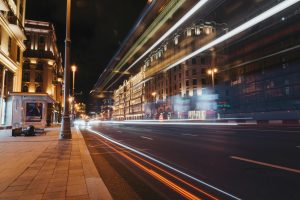Dynamic Road Pricing: Pay-Per-Mile Urban Transportation Systems
Imagine a city where traffic flows smoothly, pollution is reduced, and the transportation system is both efficient and equitable for all. This may sound like a dream, but with the implementation of Dynamic Road Pricing (DRP) – also known as Pay-Per-Mile Urban Transportation Systems – this vision can become a reality. DRP is a transportation management solution that sets prices for driving on roads based on the demand and supply of the road space. In this article, we will explore the concept of DRP and how it can revolutionize urban transportation systems.
What is Dynamic Road Pricing?
Dynamic Road Pricing (DRP) is a concept that has been around for decades, but only recently has it gained traction as a solution for managing urban traffic. Put simply, DRP is a transportation management strategy where the price of using a road is determined by the demand and supply of road space at a given time.
The traditional approach to managing traffic involves charging a fixed amount for the use of a road, regardless of the time of day or amount of traffic. This flat rate system does not take into account the fluctuation in demand for road space, which often leads to congestion and inefficiency.
On the other hand, DRP adjusts the price of using a road based on the time of day, level of congestion, and other factors. By dynamically changing the prices, DRP aims to encourage road users to adjust their travel times, modes of transportation, or routes to reduce congestion and improve overall traffic flow.
The Benefits of Dynamic Road Pricing
Reduced Congestion
Congested roads are a common sight in most urban areas, and they are not only frustrating for drivers but also inefficient and costly. DRP addresses this issue by adjusting the prices for using the road, which can significantly reduce congestion by encouraging drivers to use the roads during off-peak hours or find alternative modes of transportation. This, in turn, leads to a smoother flow of traffic and reduced travel times.
Improved Air Quality
With DRP, drivers are incentivized to use their cars less, especially during peak hours, which can lead to a reduction in air pollution. By reducing the number of cars on the road, DRP can contribute to improving air quality and creating a healthier living environment for urban residents.
Fairer Pricing
The flat rate system for road usage can be unfair, especially for low-income earners who may have to pay the same amount as high-income earners. With DRP, road users are charged based on their actual usage, which creates a fairer system. Additionally, with the implementation of DRP, the revenue generated from road usage can be used for transportation infrastructure improvements, benefiting all road users.
The Challenges of Implementing Dynamic Road Pricing
Despite its many benefits, the implementation of DRP also faces its fair share of challenges. One of the main concerns is privacy; DRP requires the use of tracking technology – such as GPS and automatic number plate recognition – to determine the number of miles traveled by a vehicle and calculate the appropriate user fee. This raises concerns about the potential invasion of privacy, and it is important for governments to address these concerns and ensure that proper privacy measures are in place.
Another challenge is the public’s perception of DRP. Many may view it as a new tax or a way for governments to make money, which can lead to resistance and pushback. To overcome this, governments need to effectively communicate the benefits of DRP and how it can improve the transportation system for everyone.
The Future of Urban Transportation with Dynamic Road Pricing
DRP is being implemented in various cities around the world, and its effectiveness has been proven in reducing congestion and improving traffic flow. With advances in technology, DRP systems are becoming more sophisticated, and its integration with other smart transportation solutions – such as real-time traffic information and digital payment systems – can create a more seamless travel experience for road users.
The future of urban transportation holds great promise with the implementation of DRP. By combining innovative technology, data-driven decision making, and fair pricing, we can create a transportation system that is efficient, sustainable, and equitable for all. The time for change is now, and DRP is a step in the right direction towards a better, smarter, and more accessible transportation system.
Conclusion
In conclusion, Dynamic Road Pricing – also known as Pay-Per-Mile Urban Transportation Systems – is a transportation management solution that sets prices for road usage based on the demand and supply of road space. Its benefits include reduced congestion, improved air quality, and fairer pricing. However, its implementation also faces challenges, such as privacy concerns and public perception. As we embrace technology and data-driven solutions, DRP has the potential to revolutionize urban transportation systems and create a greener, more efficient, and fairer future for all.







